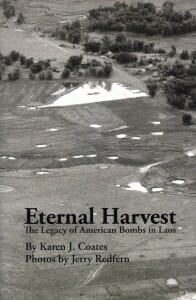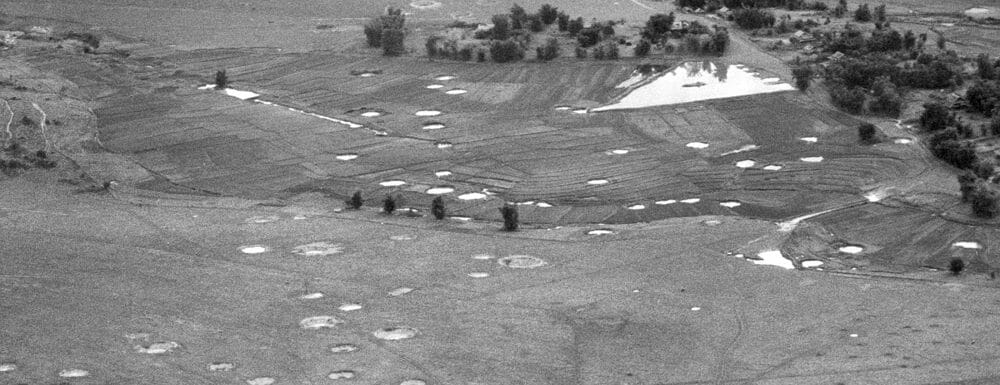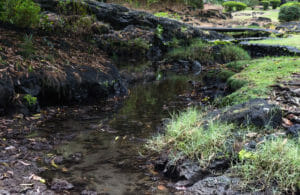 It has been 40 years since the U.S. military dropped the last bomb on Laos, yet the effects of unexploded ordnance (UXO) are being felt today. Jerry Redfern is an award-winning photojournalist who moved to Cambodia with his wife, Karen Coates, in 1998. Both are senior fellows at the Schuster Institute for Investigative Journalism at Brandeis University. It was an anniversary trip that later kindled a passion in the two about this little-known legacy of war, and encouraged a renewed commitment to redressing historical injustices and building positive peace.
It has been 40 years since the U.S. military dropped the last bomb on Laos, yet the effects of unexploded ordnance (UXO) are being felt today. Jerry Redfern is an award-winning photojournalist who moved to Cambodia with his wife, Karen Coates, in 1998. Both are senior fellows at the Schuster Institute for Investigative Journalism at Brandeis University. It was an anniversary trip that later kindled a passion in the two about this little-known legacy of war, and encouraged a renewed commitment to redressing historical injustices and building positive peace.
Redfern said, “I thought it would be cool to go to the Plain of Jars. We were living in Cambodia and were there and heard about the bombs. We decided to take an anniversary trip to the Plain of Jars.”
The Plain of Jars is an archaeological wonder of the Xieng Khouang plateau, Xieng Khouang, Lao PDR. There are thousands of megalithic stone jars clustered together. The clusters range in size from a single jar to several hundred.
“The Plain of Jars sounded fascinating,” said Redfern. “We saw bomb scrap and the extent of the problem didn’t click until we went back in 2005 and saw the scope of problem was continuing.” Until two years ago, someone was killed or injured almost every day by unexploded ordnance. But around 2010, the reported incidents dropped to about one or two injuries every week or so, yet no one can explain exactly why that happened.
“The ordnance is everywhere,” said Coates. “It’s estimated that 30% of the ordnance didn’t detonate and it contaminates 25% of every village and province. It’s most dangerous for farmers, but also dangerous for kids. While we were there, we met a 10-year-old boy who was in the hospital for bomb injuries. It’s heartbreaking.”
Tourists may not realize that they, too, could be affected by UXO. Redfern noted that the locals see the problem very differently than tourists. “The people have become inured to having this around. They see it as a tourist attraction. If they find something, they might take it back to put it on display. Tourists might assume that if someone puts something on display it’s safe. The truth is that it might not be disarmed. I’ve seen pictures of detonators on the end of mortar rounds.”
The Plain of Jars was one of the most heavily bombed areas in the country. Some locals organize “Bombie tours” to look for live ordnance. Tourists may not understand that ordnance may be live.“UXOLao, the national bomb clearance organization, allows tourists and visitors to accompany clearance teams on some controlled detonations. I should note, however, that it depends entirely on the local director and the current conditions on the ground. They obviously have to decide when and whether it’s safe for tourists to see the work. When it is, they allow visitors,” Coates said
Enterprising locals, however, have seen how these tours can bring in money and may conduct their own tours. Coates warned of the potential danger. “Never trust anyone besides a trained clearance worker. Never trust anyone who says it might be safe.”They might not be lying, but if they’re not trained, they don’t know for sure.
Luang Prabang is the capital of the Luang Prabang Province and is well known for its numerous Buddhist temples and monasteries. Roads in and out of Luang Prabang may be poorly maintained, but, according to Redfern, “There is a large circuit for backpackers. A young tourist who might go trekking through the jungles.” Redfern also issued a warning to those interested in such a trip. “Be cautious if hiking through the forest. Some of the most heavily bombed areas were in the jungles. We have come across surface munitions while we were hiking. You should never trust bomb scrap and don’t trust anyone who tells you it’s safe.”
Coates and Redfern have become so passionate about the need to raise awareness about UXO that they have written a book titled “Eternal Harvest: The Legacy of American Bombs in Laos.” More information about Karen Coates, Jerry Redfern, and “Eternal Harvest” is available at eternalharvestthebook.com.


I didn’t realize the unexploded ordinance problem continued even today in Laos. Thank you Jerry and Karen for being my guests today and talking about it.
Thank you, Terry, for allowing us the time and space. We made this book precisely because we realized so few Americans understand the continuing effects of UXO.